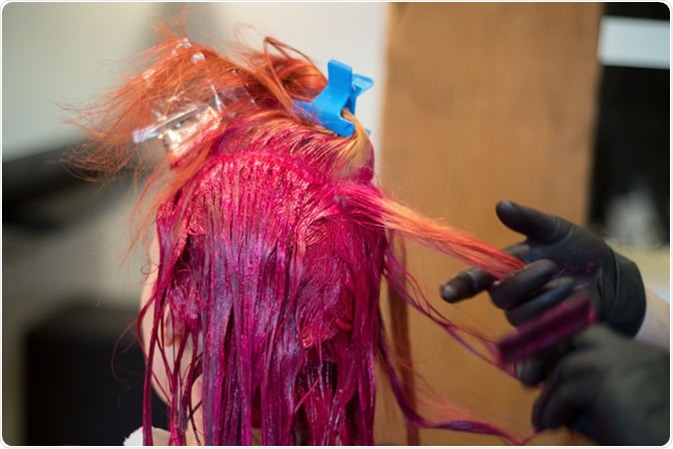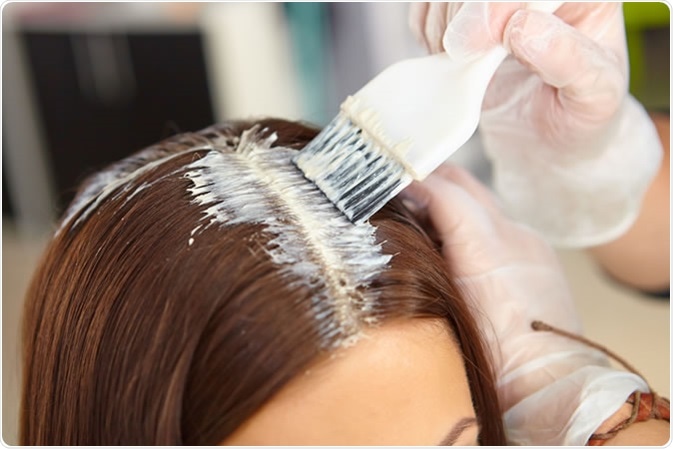Skip to:
It is thought that more than one out of threel women over the age of 18 and around 10% of men over 40 use hair dye products. There are many different types of hair dye, some is permanent, whereas others are temporary.
As these dyes are not typically natural and require numerous synthetic chemicals during manufacture, some people have raised concerns about whether some hair dye products could increase the risk of developing cancer.

Image Credit: Jefftakespics2 / Shutterstock
What is a hair dye?
Modern hair dyes that offer permanent dying often include a colourless intermediate dye which undergoes chemical reactions with hydrogen peroxide to form colour, or pigment compounds.
The darker the colour, the higher the concentration of these intermediates. This contrasts to other forms of dyes which are more temporary that include coloured compounds ready to stain the hair.
Early hair dyes contained a lot of intermediate compounds, known as aromatic amines, and animal studies indicated that they contained potentially carcinogenic compounds. As such, the industry began removing these from the manufactured product, however, some still may remain in present day dyes.
Determining each individual compounds’ carcingoenic property is difficult and it is not known whether modern aromatic amines could still present a health hazard.

Image Credit: Alex Oakenman / Shutterstock
Specific compounds can cause cancer in rodents and cell studies
The first line of evidence to suggest that hair dyes may cause cancer came from animal studies performed on mice and rats, where administration of specific amines (e.g. 2-nitro-p-phenylenediamine) resulted in carcinogenity, but others such as 4-nitro-o-phenylenediamine had no carcinogenic effects at all. These compounds have a chemical structure that resembles tar, and tar is known to be carcinogenic.
Mutagenicity assays developed by Ames and colleagues in 1975 provided a quick and efficient way of determining carcinogenity of various compounds using Salmonella. Here, 10 out of 18 tested compounds including 2,4-diaminoanisole and 2-nitro-p-phenylenediamine (already identified as carcinogenic in mice) were shown to be mutagenic. Mutagenicity refers to a compounds ability to induce genetic mutations in cells that can then go on to form cancers.
Over the years, specific amines were tested and published lists became available showing the effect of each compound on cell, animal and human studies. However, at the same time when testing commercial hair dyes applied topically, rather than administered orally in rodents, the same compounds that showed carcinogenity revealed no ill side effects with respect to their cancerous properties. This is because there intermediates need to be coupled to peroxide to form pigment, and during this reaction their mutagenic properties become limited, as long as topical administration duration is limited, as it is in humans. Still, companies have eliminated most cancer positive compounds from rodent and cell studies.
Epidemiological studies
A population study in Los Angeles, US involving 897 patients with bladder cancer found an increased risk of cancer when a permanent hair dye was used on a long-term basis. However, subsequent studies including a larger cohort of nearly 45,000 hairdressers in Sweden did not show such an increased risk of bladder cancer and hair dye usage, or handling.
Other studies looking into hairdressers and cancer risk have found similar patterns where the risk of bladder cancer was increased in hairdressers compared when compared with a control population.
Here there may be a discrepancy between hairdressers, who routinely are exposed to these dyes and chemicals, as opposed to users of hair dyes.
Hairdressers are also exposed to other potentially carcinogenic compounds and volatile solvents and thus proving causality may be difficult.
Another study found the same associations for male hairdressers but not female hairdressers. It is often hard to control for confounders such as smoking and lifestyle factors such as alcohol and exercise which all play a role in cancer development. This is supported by a Spanish study which failed to establish a positive association between exposure to dye in female hairdressers.
Most research have shown no significant increased risk of developing cancer with personal hair dye usage. However, there are some notable studies which identified an increased risk of bladder cancer with users of permanent hair dye users in females who used dyes more than 12 times a year, for more than 15 years. Therefore, regular usage of permanent hair dyes for a long time may increase the risk of cancer.
Other studies have shown moderately increased risk of developing non-Hodgkin lymphoma and leukaemia, but many other studies have failed to see these effects and associations.
Where there is an effect, users of hair dyes were typically using dyes pre-1980s (older studies) when aromatic amines were still used.
It is important to note that hair dye manufacturing varies country to country, and observations within the EU/UK may be different to non-EU, US/Americas and Asian countries. Furthermore, the darker the dye (black), the higher the risk of cancer than lighter dyes. It is also important to analyse the studies based on this observation.
Though a majority of studies have focused on dye users before 1980s where significant increased risk of cancer exists, post-1980s, such effects are now minimised due to removal of specific compounds.
In summary, there is no evidence to support a definite association between modern personal hair dye usage and increased cancer risk, based on numerous epidemiological studies.
The difference between studies on animals and cells are due to testing specific compounds without peroxide and other compounds, as well as route of administration.
Studies on hairdressers particularly males (up to the late 1980s) show that exposure to hair dye may have increased cancer risk, but many of these could have been due to other factors such as increased prevalence of smoking and alcohol intake in this population.
Modern hair-dyes, including permanent dyes, therefore do not pose a significant risk to cancer development and can be used safely.
Further Reading